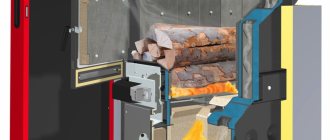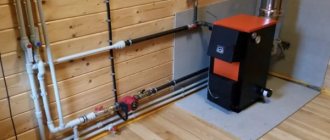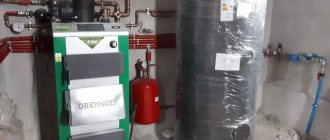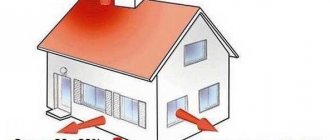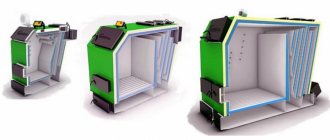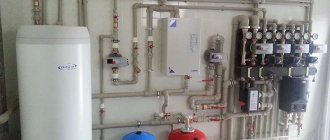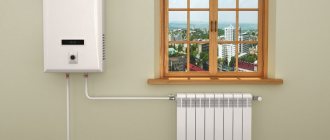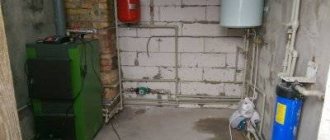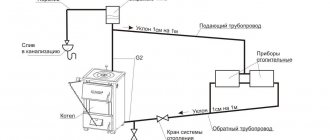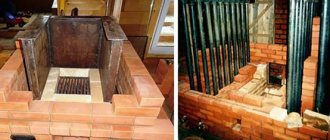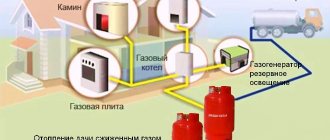Category: Tips Published 02/21/2016 · Comments: · Reading time: 4 min · Views: Post Views: 9,140
Hello, friends! Have you ever thought about how reliably your boiler is protected from overheating? Sometimes, when firing a solid fuel boiler, the coolant temperature has reached a critical value, but the fuel still continues to burn. This releases a significant amount of heat, which can have serious consequences both for the boiler and for the entire heating system as a whole.
The heating system with a solid fuel boiler is inertial. This positive quality of solid fuel boilers can play a fatal role if the coolant is overheated. In this case, it will not be possible to immediately stop the ongoing heating of the coolant. A particularly catastrophic situation arises if the heating system contains polypropylene or metal-plastic pipes. Their operation is not designed for such a high temperature, which will inevitably lead to depressurization of the system.
In this case, there is no longer any hope for a safety system consisting of an expansion tank, a drain valve, and an automatic air vent. It just protects the system from excess pressure. But, when the life of the expansion tank has already been exhausted, the growing pressure in the system causes the release valve to operate, and part of the coolant is discharged from the system.
It seems that the situation should improve, but it is only getting worse, because... a decrease in the volume of coolant leads to more intense boiling of water in the boiler. The temperature continues to rise, and now... But it is not all that bad. Boiler manufacturers have also foreseen this scenario. Modern boilers are equipped with devices that prevent the boiler from overheating. But we’ll try to figure out how effective they are in this article.
Protection of a solid fuel boiler from low-temperature corrosion
In the boiler firing mode at a coolant temperature of less than 55-65 degrees. Condensation falls from the flue gases on the surface of the heat exchanger in the boiler. Condensate mixes with fuel combustion products and gradually clogs the heat exchanger , which reduces the efficiency of the boiler. In addition, deposits contain acid, which accelerates metal corrosion and significantly reduces the service life of the boiler and chimney.
To protect the boiler from low-temperature corrosion, the temperature of the water in the return pipeline, at the entrance to the boiler, during firing, must be raised above 55-65 degrees as quickly as possible and not reduced further.
| Scheme for protecting the boiler from low-temperature corrosion. When the boiler is fired up, the coolant circulates only through the boiler circuit KK |
The boiler protection unit against low-temperature corrosion (item 6 on the heating diagram) divides the circuit into two circuits - on the boiler protection diagram, KK - boiler circuit and OK - heating circuit.
When lighting the boiler, a three-way valve directs the circulation of the coolant along the boiler circuit, past the heating devices. As a result, the coolant and boiler quickly warm up.
After the temperature of the coolant in the boiler circuit rises to more than 55-65 degrees, the three-way valve begins to gradually mix and add water from the heating circuit.
Thus, the circulation of coolant in the heating circuit begins only after the boiler circuit has quickly warmed up. The temperature of the water in the return pipeline at the entrance to the boiler, while the fuel in the boiler is burning, always remains above 55-65 degrees.
Firewood quality
The best firewood for a solid fuel boiler has always been oak firewood. Due to its high quality, these raw materials belong to the elite class. The cost of oak firewood is high, so it is not affordable for everyone. But such firewood is often indispensable when it comes to the taste of baked bread, pizza or other pastries. Here oak logs are simply irreplaceable.
Let's look at the characteristics of firewood from different types of wood:
- Oak: an elite, expensive variety. Burns powerfully, giving off a huge amount of heat;
- Birch: Best quality/cost ratio;
- Alder: excellent firewood, the house warms up quickly. In addition, the ancestors considered alder firewood to be “medicinal”, since in a house heated with its help, people were less likely to get colds;
- Pine: hot and aromatic firewood that burns well due to its resin content.
Boiler protection against power outage
Modern boilers and other boiler room equipment are equipped with electrical and electronic equipment to varying degrees. Circulation pumps, air blowers, electric valves, electronic control units, protection and monitoring, displays - all this equipment requires a constant supply of electricity.
Even short-term power outages disrupt the operation of the heating system. Power outages are especially painful for solid fuel boilers.
In systems with a solid fuel boiler, overheating protection is triggered and the fuel combustion process stops. To restore the boiler operation, human intervention is required.
To ensure that the operation of the boiler room does not depend on power outages, the electrical equipment of the boiler room is connected to an uninterruptible power supply (UPS). The source of uninterrupted power supply in European countries has long become standard boiler room equipment.
The electrical equipment of a boiler room in a private house consumes relatively low power electricity. Uninterruptible power supplies and batteries are not so expensive compared to other boiler room equipment. The battery life when working with a power supply is 15-20 years. (do not compare with a car - the battery operating conditions are different there).
I highly recommend equipping your boiler room with an uninterruptible power supply, you won’t regret it.
When the mains voltage disappears, the unit instantly, without interruption or in a split second, switches the power supply from the battery. The operation of the electrical equipment of the boiler room may not stop for a moment.
Batteries in UPS for boilers are purchased and installed separately. UPS manufacturers usually suggest using lead-acid batteries made using AGM (Absorbent Glass Mat) technology. The difference between AGM batteries and classic ones is that they contain absorbed electrolyte rather than liquid, which gives a number of changes in the properties of the battery. They claim that such batteries are better suited to work as part of a UPS - they can withstand a greater number of charge-discharge cycles, do not emit hydrogen during charging, and provide a service life of more than 10 years. True, the price of AGM batteries is approximately 2 times more than conventional starter batteries.
From the experience of home craftsmen, it is known that if a regular car starter battery is not discharged below 1.8 V
with a connected load (or 2.0
V
without load) per cell, and do not allow the electrolyte to boil for a long time during charging, then their service life will be no less than that of AGM batteries.
The battery capacity is selected so as to ensure the operation of the boiler room equipment at least for the duration of combustion of one load of fuel. For example, a battery with a capacity of 65 Ah will be able to operate a boiler room with a circulation pump in a heating system with a power of up to 100 VA for approximately 7 hours. The uninterruptible power supply for the boiler room should have a power approximately 4 - 7 times greater than the power of the circulation pump.
Which UPS for the boiler and pump to choose
A rechargeable battery with a capacity of 65 Ah can provide operation of a circulation pump with a power of up to 100 VA for approximately 7 hours.
You should choose a UPS specifically designed for power supply to boilers and electric motors of circulation pumps. For boilers and boilers with equipment whose operation is disrupted even during short-term interruptions in power supply, it is imperative to use a UPS with double voltage conversion - On-line (Ol) technology. In such a UPS, alternating mains voltage is converted to direct voltage, which continuously charges the battery and is supplied to the inverter. The inverter converts the resulting direct voltage into alternating voltage of a pure sinusoidal form, as in the electrical network.
UPS of this class (double conversion or on-line technology) provide the best level of output voltage stabilization and noise immunity. Since the boiler constantly receives electricity through the inverter, if there is no voltage in the network, the load immediately begins to receive power from the battery. Such a UPS must be chosen to connect boiler room equipment with an electronic microprocessor control system, for example, modern gas boilers
For boiler houses with equipment that allows short-term interruptions in the power supply, it is possible to install line-interactive UPSs manufactured using Line-interactive (Li) technology. Such UPSs switch the power supply of the boiler room to batteries with a break in a split second. As soon as voltage appears, they switch to power from an external network and begin to charge the battery. The system is fully automatic and does not require human presence. However, even such a short break is enough for the electronic microprocessor control system of the boiler to freeze. A UPS with a linear-interactive operating mode is suitable for connecting solid fuel boilers and circulation pumps.
Inexpensive UPS (Li) 1000 W on AliExpress for RUB 11,763. ($180) with delivery 15 days. Buy with cashback (delayed discount - returns up to 15% of the cost - more details...). Can work with a regular car starter battery.
Some sellers under the brand UPS (UPS) sell simple inverters - devices that convert DC battery voltage into alternating voltage, like in the mains. But these devices cannot automatically switch the power supply to the boiler from the network to the inverter and back. Such inverters can be used for backup power supply to boiler room equipment . Only the owner himself will have to remove the boiler plug from the electrical outlet and plug it into the outlet on the device body, and then do it back. The owner also needs to take care of charging the battery. This option will ensure minimal costs for the purchase of equipment for backup power supply to the circulation pump. You need to purchase a car inverter with a pure sine wave output voltage and a car battery.
If you also connect the pump supplying water to the house to an uninterruptible power supply, then in the heating circuit you can dispense with the water reserve tank, pos. 2, and the float valve, pos. 3.
In a house with a solid fuel boiler, it is recommended to have, in addition to an uninterruptible power supply in the boiler room, also an autonomous electric generator for backup power supply to all household electrical appliances.
We heat it with coal.
When choosing coal as a fuel for the boiler, carefully read the instructions to see if this type of fuel is suitable for your boiler. If no problems arise, we learn.
To produce the best level of heat, coal fuel will require a special firebox - a shaft with vertical walls and a grate. The firebox must be high, from the arch to the grate it must be at least 50 cm. It is recommended to make the blower and combustion doors of cast iron, strictly seal them, the optimal distance between them should be about 21 cm. When burning coal, you should remember that a new portion should be added only when when the first one has confidently flared up, each time it is necessary to close the ash door, and also not to allow the coal to burn through to the grate, maintaining an even layer.
It is worth remembering that coal, coal grades PZh and Zh, PS and SS, as well as grade T require wetting according to the instructions. And only anthracite does not require wetting, if only to reduce dust emissions.
For optimal combustion, the coal should be chopped into pieces measuring 30-50 cm.
Heat accumulator in a heating system with a solid fuel boiler
The supply of fuel to solid fuel boilers cannot be automated. For this reason, solid fuel boilers are intermittent devices. They heat the coolant only during the combustion of the next portion of fuel. The house is sometimes hot and sometimes cold.
In order to smooth out temperature fluctuations, it is necessary to load fuel more often.
Long-burning solid fuel boilers have their advantages and disadvantages, but they do not radically solve the problem.
In a house heating system with a periodic solid fuel boiler, it is advantageous to have a heat accumulator , which accumulates thermal energy during the operation of the boiler and releases heat to the room during a pause. The presence of such a heat accumulator stabilizes and optimizes the operating mode of heating a house with a solid fuel boiler. In a system with a heat accumulator, temperature fluctuations in the house slow down, their amplitude is reduced, and the frequency of fuel loading increases. The boiler always operates in optimal fuel combustion mode, with maximum efficiency, which saves fuel. The house itself is a kind of heat accumulator. All materials in the house have the ability to accumulate heat - heat capacity, and release heat when the air temperature in the room decreases. The higher the heat capacity of the house’s structures, the better - the slower the temperature in the rooms changes, the more comfortable it is in the house and the less often you have to load fuel.
Household products
⇆
The greater the mass and density of building materials, the higher their heat capacity.
You've probably noticed that buildings with thick stone walls are warm in winter and cool in summer.
Modern construction technologies are moving in the opposite direction.
Building structures are becoming lighter, and the use of low-density materials is increasing.
For example, a house built using frame or frame-panel technology can provide thermal comfort to residents only if the heating and air conditioning systems operate almost continuously. After all, the heat capacity of such a house is minimal.
People learned to use thermal energy accumulators in houses with reduced heat capacity a long time ago. A Russian stove in a wooden house is a huge, heavy brick structure, a classic example of a heat accumulator in a house
with a small heat capacity of wooden walls.
In modern conditions, in order to increase the comfort of a home heating system with a solid fuel boiler, it is convenient and profitable to use other methods of heat accumulation.
Fuel
What is the advantage of a solid fuel boiler? Such a boiler can be heated not only with wood, but also with fuel briquettes (pressed sawdust, bark, shavings, peat), fuel pellets and coal.
Since firewood is the most common and cheapest type of fuel, owners of private houses and cottages often prefer it. When choosing firewood, you should take into account the calorie content of the wood species. The higher the calorie content, the less firewood will be needed to warm the room to the desired temperature.
Concrete screed for heated floors - a heat accumulator for a solid fuel boiler
It is convenient to use a heated floor concrete screed as a heat accumulator. And that's why.
Water heated floor structures contain a fairly thick layer of concrete. Heavy and dense concrete has a high heat capacity.
It is recommended to increase the heat storage capacity of a concrete floor screed in a house with a solid fuel boiler by increasing the thickness of the screed (up to 15 cm or more) compared to the standard one. This floor is a kind of analogue of a Russian stove in a modern home.
As a result, the warm floor becomes a storage heater, like a brick oven in a house.
The capabilities of a heated floor as a heat accumulator are limited by the fact that in rooms of the house where people are constantly present, the floor surface temperature should not be higher than 29 °C. In other rooms, the floor cannot be heated to a surface temperature above 33°C. It is allowed to heat the floor surface up to 38°C, but only for a short time.
To increase the thermal capacity of the screed, the thickness of the concrete layer of the screed is increased. It should be taken into account that in this case the weight of the screed and the load on the floors increases.
A certain difficulty when powering water underfloor heating from a solid fuel boiler arises from the need to limit the temperature of the water in the system. The optimal temperature of the coolant at the outlet of the boiler is approximately 85 °C, and water with a temperature of about 45 °C must be supplied to the underfloor heating pipes.
Therefore, devices must be installed between the boiler and the heated floor to reduce the temperature of the water supplied to the pipes of the heated floor.
The main disadvantage of using a concrete screed as a heat accumulator is that it is impossible to control the reserves of heat accumulated in the screed. The stored thermal energy cannot be consumed and moved at our will. We are unable to delay or reduce the flow of heat into the room from the heated screed. We cannot transfer heat to the next room.
Buy solid fuel heating boiler
Solid fuel heating boiler wood
⇆
Tips for the developer
Pyrolysis boiler
operates stably at a constant load close to the rated power of the boiler. This operating mode can be ensured if the heating system is equipped with a buffer tank - a heat accumulator.
A heating system with a heat accumulator will allow you to heat the house with a pyrolysis boiler even in the off-season . But the cost of equipment for such a boiler house will be quite high. The need to prepare dry fuel for the boiler also causes certain difficulties in operation.
For long-burning boilers, firewood with a humidity of no more than 20-30% is required in the upper layer.
When naturally dried in a woodpile, chopped firewood acquires the specified moisture content only after two years of storage under a canopy. If you do not see any difficulties in obtaining such firewood, then install such a boiler. The boiler provides the longest and most uniform heat release in a wide range of power settings.
Evaluate the affordability and reliability of supply of granulated fuel for an automatic solid fuel boiler. Heating a private house with an automatic boiler is the most convenient solution for owners.
A heating system with a traditional boiler and heat accumulator is simpler, cheaper and more reliable in operation
Modern boilers are designed to ensure maximum fuel combustion efficiency. They have a developed heat exchange surface and low temperature of exhaust gases. As a result, solid fuel boilers are more prone to condensation and soot deposits on the walls of the boiler and chimney than brick stoves.
When burning in a boiler, try to use hardwood wood with minimal humidity.
This will extend the life of the boiler and chimney. In addition, dry firewood reduces fuel costs - wood with a moisture content of less than 25% releases twice as much heat during combustion as the same wood with a moisture content of more than 50%.
Supplement the heating system with a solid fuel boiler with an electric boiler.
Use an electric boiler to heat your home in the off-season, until the cost of heating with electricity is not burdensome for your budget, and the boiler’s power is sufficient for heating.
The power of the electric boiler when connected to a conventional single-phase electrical network should be no more than 5 kW. Try to connect a house with a solid fuel boiler to a three-phase power supply. It will be possible to use a more powerful electric boiler, and turning on the boiler will reduce the voltage in the electrical network less.
Be sure to install a draft limiter in the chimney system of a solid fuel boiler with natural draft.
. A draft limiter is a valve that, when a certain pressure difference between the pipe and the room is reached when adjusting, opens slightly and allows air from the room into the chimney, which reduces the draft. Typically, a draft limiter is installed in the chimney below the boiler connection point. The limiter reduces the dependence of the thrust intensity on external conditions - wind, outside temperature and humidity. This stabilizes the combustion regime in the combustion chamber of a solid fuel boiler with natural draft.
In a house where the main source of heat is a solid fuel boiler, it is recommended to install heated floors in all rooms. If radiators are installed in certain rooms, then due to their low thermal inertia, such rooms will cool and heat up faster. In the intervals between boiler fires, temperature fluctuations in rooms with radiators will be greater than in rooms with heated floors.
In a room with heated floors, the distribution of air temperature across height becomes more uniform. Thermal comfort in the room is ensured at a temperature 2 °C lower than when heating with radiators, which allows saving fuel for heating.
Read about a more advanced home heating system using a solid fuel boiler with a buffer tank - a heat accumulator.
What kind of solid fuel boiler heats your home?
Vote! Find out what others have chosen.
Look!
— all polls
More articles on this topic:
⇒ Solid fuel heating boiler with a heat accumulator - buffer tank ⇒ Heating circuit with a solid fuel boiler and buffer tank ⇒ Forced heating circuit with a solid fuel boiler (without a heat accumulator)
Read page: Page 1, Page 2
More articles on this topic
- Painting the facade and exterior walls of the house
- Leveling, wall covering with dry plaster and plasterboard
- Apartment redevelopment - fresh ideas
- Do-it-yourself floor with a dry prefabricated screed made of gypsum fiber board or gypsum fiber board sheets
- Technology for assembling the walls of a house or bathhouse from building timber
- Choosing a soft roof for the roof of a private house
- There is formaldehyde in the house, the source is chipboard, OSB, plywood, mineral wool
- Minimum thickness of a wall made of bricks or blocks
Maximum net power
This characteristic can be called one of the most important. When choosing a boiler, it is the first thing people pay attention to. This is not surprising, because the area of the room that the boiler can heat depends on the power.
The Zota company produces boilers with capacities of 15, 25, 40, 63 and 100 kW .
The range of capacities of pellet boilers is large, which allows you to choose a boiler for your needs, be it heating a private home or an industrial premises.
It is generally accepted that a boiler with a power of ten kilowatts can heat a room of 100 square meters.
How to calculate chimney sections
When choosing, you need to first measure the existing cross-section of the pipe. It should have the same dimensions. It is desirable that the sizes match. If the diameter is larger, a drop in pressure will occur and the traction force will decrease. It is prohibited to operate two solid fuel boilers with one chimney. Each must be equipped with a separate pipe. With the correct selection of diameter, as well as competent installation, there will always be good traction.
The cross-sectional size (sq. m) is determined by the formula:
volume of fuel consumed (m3/s) / gas velocity.
The chimney can have different cross-sectional shapes:
For normal operation, you can use any option, but a round section is still much preferable. When smoke moves inside the pipe, it spirals. Any foreign part in the pipe creates resistance to the movement of the gas flow.
If the inner surface of the pipe is rough, the gas velocity will decrease. When smoke, during circular movements, collides with a right angle, a sharp change in trajectory occurs, and mixing occurs. As a result, soot settles in the corners.
Constant, thorough cleaning will be required.
Design and principle of operation
The device diagram is quite simple. The main structural elements are:
- temperature control handle;
- rod and guide;
- actuating mechanism;
- immersion sleeve;
- temperature sensitive element;
- spring;
- drive lever;
- handle and lever mounting screws;
- chain.
The main component is a sensor that responds to temperature fluctuations. It interacts with a spring, which, when heated or cooled, activates the working part (sleeve and rod).
That, in turn, is connected through a mechanical drive to the fuel compartment flap. The draft regulator for solid fuel boilers, under certain conditions, opens and closes the door, maintaining the set temperature.
The principle of operation of the device is banal, but still effective. When the damper opens slightly, more air enters the firebox. Due to this, fuel combustion occurs more intensely, more heat is released, and the room is heated more efficiently. When the valve closes, the fuel is less supplied with oxygen and barely smolders.
If we briefly describe the operation of the draft regulator, based on design features, we get the following diagram:
- when the heat load decreases, the thermostatic sensor reacts to fluctuations;
- the sensor increases the spring tension;
- the spring lifts the lever;
- the damper opens;
- the combustion intensifies.
To reduce the intensity of the process, the steps are performed in reverse order.
The regulator body has a handle with a temperature scale. This sets the required minimum value. The temperature will rise as necessary, but will never fall below the set level.
On the regulator body there is a handle with a temperature scale, so the required minimum value is set.
Step-by-step installation progress
Any instructions supplied with the boiler contain recommendations for installing the equipment. Installation of a solid fuel boiler must be carried out strictly according to the manufacturer’s instructions and technical rules.
The sequence of actions must be followed.
Base
First, you should build a solid base of non-combustible material under the bottom 20 cm wider than the base of the unit; it is best to pour a concrete base. After this, you need to install the boiler on a solid base, taking into account all distances, and adjust the horizontal and vertical positions of the device.
Connecting pipes and safety elements
Adhering to the connection diagram, insert a complete safety group for this type of boiler, which is installed up to the shut-off valves.
After this, the heating pipes should be connected, it is advisable to make the connection through shut-off valves, and carefully seal the joints with flax or plumbing tape.
Chimney
Next, you need to assemble a chimney, good draft in which depends on the correctly selected cross-sectional area and height of the pipe; all connections must be coated with heat-resistant sealant.
Final stage
At the next stage, you can fill the heating system with water at higher pressure and check for leaks. After which it is necessary to check the location of the grates, dampers, plugs, and fireclay stones. At the end of the installation, you need to reduce the water pressure to working pressure, install dampers in the chimney and firebox, and load firewood.
Now you can light the boiler, when the design temperature is reached, turn on the thermostat to the selected heat supply level for comfortable heating of the room and do not forget to add firewood to the firebox in a timely manner.
Classification
It is customary to divide existing temperature sensors into two large groups. In the first group, sensors are classified depending on the method of determining temperature, and in the second group - according to the method of interaction of the device with the thermostat. One does not exclude the other: one model can be present in the classifier of each group of temperature sensors.
By method of determination
The correct operation of the temperature sensor at the facility depends on the method for determining temperature. There are several types of sensors, differing in price and accuracy of determining the parameter.
Dilatometric
A dilatometric (volumetric) sensor is a bimetallic plate or spiral made of a material with a high coefficient of thermal expansion. When heated, the plate bends and the contact at the end of the plate opens with the stationary relay contact, preventing the flow of current. Delayed thermostats use a coil that slowly opens or contracts as the temperature changes.
Resistive
Resistive temperature sensors use a thermistor (thermistor). This is an unusual resistor made of copper, nickel or platinum, the electrical conductivity of which varies in direct proportion to temperature. Depending on the resistance of the thermistor at the current moment, the heating or cooling mode of the boiler is automatically selected.
Thermoelectric
The action is based on the property of a thermocouple - a thermoseal made of two metals of different types (iron-nickel, nickel-chrome) to produce an emf when heated at the point of contact, proportional to the temperature, up to 40–60 µV. Such low voltage values impose special requirements on the equipment used in signal processing: precise, multi-bit converters with a minimum level of intrinsic noise are used.
In a simple non-volatile boiler, a thermoelectric sensor directly controls the solenoid valve for supplying gas to the main burner after heating the thermocouple with the pilot flame.
Gauge
The operating principle of pressure sensors is based on changes in gas/liquid pressure in a closed volume. They do not require an external power source, which is convenient for remote measurements. The disadvantage is the high inertia of readings and the low sensitivity of this type of device.
By type of interaction with the thermostat
The type of interaction with the thermostat is selected depending on the location of the sensor, taking into account the ergonomics of the hot water system. Along with the traditional wired connection method, wireless connection schemes are gaining popularity.
Wired
By definition, wired boiler fixtures transmit data through wires. Conductors connect the sensor to the control unit of the heating unit.
Wireless
The operation of a wireless device is similar to the principle of working with Wi-Fi. The signal enters the radio module, the receiving module in the water heating installation receives it, and the built-in controller of the control unit processes and converts it into a control pulse.
By placement method
Depending on the ability to be placed in space, thermal sensors are divided into several types. There are overhead, submersible and indoor types of devices.
Overhead
Overhead sensors are called sensors with external mounting to the heating circuit. The sensitive element is placed on the outside of the supply or return pipe and is attracted to it with clamps, after which it is tightly wrapped around the outside with a heat-insulating sleeve.
Submersible
Submersible products are in direct contact with hot water or coolant. They are installed in special mounting holes on the pipeline, provided for by the design of the equipment, at the outlet of the heat exchanger. The disadvantage of submersible products is the need to drain the coolant from the hot water system when replacing.
Indoor
Room devices are devices located inside residential or office premises. The room in which the air has the most constant temperature is selected. The most suitable place to locate the sensor/thermostat is a wall. The device should be placed at a height of no more than 120–150 cm from the floor.
Types of temperature sensors
There are the following types of common devices:
| № | Helpful information |
| 1 | Thermocouple |
They consist of a pair of wires made of different metals soldered together. The temperature difference between the cold and warm ends of the wire causes a weak current to occur, the value depending on the type of metal.
The thermocouple is a highly accurate system for measuring changes in temperature, but it is difficult to perform calculations on it. The difficulty is, among other things, the creation of special conditions for both ends of the thermocouple and special measurement systems, the very process of taking the temperature of which is associated with possible interference from other sources.
Thermistors.
Much easier to use than a thermocouple. The measurements are based on the principle of changing the resistance of materials depending on the ambient temperature. Devices made, as a rule, from platinum have high accuracy and ease of measurement.
By connecting the device to the current source circuit and measuring its differential. voltage, get the resistance value. Such a device can be easily connected to converters of the obtained values into digital, thereby carrying out thermal control through the main processor.
Digital sensors.
A now popular model, created in the form of a board with three outputs. The outputs measure temperature readings from several sensors simultaneously, with an error of only 0.5 degrees. Also, the advantages of this device include a wide range of operating temperatures, but the disadvantage is slow operation. Such meters are often used in heating systems.
Thermal imagers.
They, in turn, are divided into three types: radiation, optical, color.
The difference between both differences and advantages is the possibility of external interference on their measurements. Measurement range. Chemical and physical factors. Each of them takes place under certain conditions of use and under certain needs.
Quartz.
The operating principle is based on the frequency dependence of quartz with heating. Their advantages include high accuracy and resolution. Long service life and wide application possibilities. It is believed that they are the technologies of the future.
Noise.
They work on the difference in acoustic potential depending on the degrees of the resistor.
The method of application is simple. High level measurement range and quality. However, a large amount of interference that can affect the measurements of the device most often reduces its operation to nothing.
There are many more types of temperature sensors based on different principles, and existing for different needs, but they are no longer so common in domestic conditions.
Types of control devices
Thermostats for heating boilers with the option of temperature control are divided into several types:
- mechanical models with one function;
- programmable models with a large range of auxiliary settings.
Wireless models
Also, similar designs are wireless and wired. Thermostats are installed in the selected location, a temperature sensor is connected and connected to the control device.
Design diagram of the control device
Selecting a room programmable device
The option of an electronic temperature sensor for a heating boiler helps you select the appropriate temperature mode and change it at your discretion. The room thermostat sets the set values every day. Some setpoint values can be programmed, for example when day turns to night.
Such controllers have additional options. For example, a function that allows you to stop heating for a while and then resume it. You can also change the programmable temperatures for the duration of the configured periods. Another useful option is the ability to change the heating intensity.
Room type regulator
Thermostat as a central element
The central thermostat for the heating boiler (temperature regulator) is located at a certain distance from the heating unit and allows you to turn off and turn on equipment throughout the house.
Installation diagram of thermostats in the heating system
Related article:
Models from previous years are connected directly to the heating unit by wires, while more modern designs are distinguished by remote control. The latest devices are mounted in dual-circuit units Beretta, Ferroli and AOGV. Room control mechanisms for boilers of the Protherm and Gsm brands are popular. They differ in their dilatometric mechanism.
Protherm equipment models
Room devices stop heating when necessary. They monitor the air temperature and turn on the heating when the temperature drops. The best place for a microcontroller is considered to be the bedroom and living room.
Installing a controller will allow you to obtain accurate data on the microclimate of the room
Thermostatic valves for regulation
Such a device allows you to create a certain coolant temperature by mixing the forward and return flows. The device helps control temperature values by changing the flow of hot water through the battery. In this case, the mechanism controls the supply of hot water through the battery, but not through the boiler. It is installed in any room where you need to maintain a certain temperature.
Thermostatic valve design using the example of a specific model
Programmable thermostats
Programmable thermostat is a digital regulator of the temperature of the coolant in the heating system and the air in the heated room. It consists of a thermostatic head in the form of a bellows with a rod filled with liquid/gas, and an electronic part with a programmer. Depending on the entered operating algorithm, the rod reduces or completely shuts off the coolant supply. Using the keys and display of the programmable “thermo”, temperature parameters, day and time of start, and duration of the mode are set. The device will perform all subsequent actions independently.
Chimney device
All chimneys, regardless of the material used, location and design, have a similar structure.
They always contain the following components:
- Chimney is a vertical or partially inclined channel (pipeline) of rectangular, square or round cross-section for the removal of combustion products. Made from durable fire-resistant material.
- Condensate collector - located in the lower part of the chimney after the boiler flue is inserted and serves to collect condensed vapors contained in the flue gases. Equipped with a dump valve. Absent in mounted chimneys, made double-walled with a heat-insulating layer.
- The draft control device is a rotary or retractable damper.
This is interesting! Unlike the chimneys of gas-fuelled boilers, solid fuel boilers are equipped with wind vanes and various types of deflectors to improve draft and prevent precipitation.
Calculation of chimney parameters
Correctly selected height and cross-sectional area of the chimney is the key to its reliable operation. Almost all industrial boilers have recommendations regarding these values.
For equipment with thermal power up to 90 kW, the following values are recommended:
| highly qualified masons are required, the rectangular cross-section and not ideally smooth internal walls create additional resistance to the movement of flue gases and contribute to clogging with soot. | |||
| Ceramic chimneys | Chimneys made of ceramic pipes and blocks are a heavy structure. | moderate weight, durability, aesthetic appearance, no condensation | considerable price, need for qualified specialists |
| Steel | Steel pipe chimneys (single wall) made from black or galvanized pipes. | characterized by low price, ease of assembly, satisfactory weight characteristics and fire safety | short service life, susceptibility to corrosion and the need for thermal insulation to prevent condensation. |
| Stainless steel chimneys | Stainless steel pipes are quite expensive, which does not contribute to their popularity. | ease of installation | |
| condensation may form on the walls | |||
| Double-walled structures made of sandwich pipes with thermal interlayer | Recently they are increasingly in demand | light weight, compactness, ease of installation, protection against condensation, resistance to high temperatures and aggressive environments, a perfectly smooth inner surface and a round cross-section of the pipe prevents the deposition of soot inside the chimney. | quite high cost and service life of only 15 years |
| Boiler performance, kW | Chimney diameter, cm | Pipe cross-sectional area, cm2 | Pipe height, m |
| 20 | 13 | 196 | 7 |
| 30 | 15 | 196 | 8 |
| 45 | 18 | 378 | 9 |
| 65 | 20 | 540 | 10 |
| 90 | 25 | 729 | 12 |
Pipe height
This size is determined by SNiP, which sets certain parameters:
- If the roof is flat, the chimney should rise 1.2 meters above it.
- If the chimney is located near the ridge, and the distance is less than 1.5 meters, it should rise above the ridge by 0.5 meters or more.
- When the pipe is located in the range of 1.5 - 3 meters to the ridge, it should not be below the ridge line.
- If the location of the chimney from the ridge exceeds 3 meters, its height should be on a line extending from the ridge, maintaining an angle of 10 degrees relative to the horizon line.
What materials should exhaust pipes be made of?
With a wide variety of materials, only a few types can be used to operate a chimney. The main ones are:
The most popular are pipes made of brick. They are able to withstand very high temperatures. Its maximum reaches 1000 degrees. Today, on the roof of modern expensive cottages you can see an original chimney made of eurobrick. However, upon closer examination, you can see pipes inserted inside the brick chimney. They can be steel or made of ceramic. This is explained very simply. One brick is not suitable for normal operation. In other words, it will work, but not for very long. It will quickly be destroyed by caustic condensation. Therefore, a liner is inserted into the brick pipe. Free cavities are filled with insulating material.
Sandwich pipes made of ceramics can withstand very high temperatures. It can exceed 1200 degrees. This value is much higher than the maximum smoke temperature after coal combustion.
Such a pipe is not afraid of condensation and any atmospheric phenomena. Condensate is drained through a special drain hole. Sometimes for this purpose an additional container is made at the end of the watering can. A ceramic chimney pipe is installed on the facade or inside the building.
A chimney of the Schiedel Uni brand, if a soot fire occurs, is able to cope with such a thermal load. When burning, soot heats up to a temperature of 1100 - 1200 degrees.
Disadvantages of ceramics
They do not have a beautiful appearance. Their cost is much higher than their steel counterparts. Installing these pipes requires construction skills and experience. These pipes remain popular among consumers with low incomes.
Metal chimney
For its manufacture, ordinary steel or stainless steel is used. Unfortunately, steel chimneys cannot withstand
aggressive environment. When the boiler operates continuously, the pipe will become unusable in a very short time and may cause a fire.
The composition of the stainless steel used includes special additives consisting of several chemical elements
They are the ones who save stainless steel from corrosion. For installation
The following steel grades are used in boilers:
- 316.
- 316 L.
- 321.
They contain substances that allow steel to withstand temperatures within 700 - 800 degrees. These grades of steel are not afraid of condensation, they are neutral to acids, and do not react with other aggressive substances.
The cost of a chimney made of stainless steel is affordable to the average buyer. It is considered most suitable for installation in a solid fuel boiler.
Glass chimney
Very rare. Its positive qualities include:
- Low thermal inertia.
- Corrosion never occurs.
- Original look.
The cost of such a design is very high. Therefore it is very rare. In addition, its installation is very labor-intensive and costs a lot of money.
Heating system installation
Installation of the heating system of a country house is carried out in several stages:
- project development, obtaining permits from the relevant authorities;
- purchase of materials, equipment and preparation of tools;
- insertion into a gas pipeline that runs along the street and through which gas is supplied to residential buildings;
- preparing a place for a gas boiler, laying out pipes;
Installation of gas equipment
boiler installation; filling the system with coolant; diagnostics.
The main criterion by which the amount of materials is calculated and the model of heating equipment is selected is the area of the house. The larger it is, the more powerful the device will be needed. For a small house, a small-sized boiler is suitable, which can be installed in the bathroom or kitchen. For a cottage or two-story mansion, it is better to choose a large, powerful device.
A heating system in a private home installed in accordance with all the rules will function for a long period. Before starting installation work, you should familiarize yourself with the heating diagram and the rules for installing heating equipment.
Selection of coolant
When studying the question of how the heating system works in a private house, you need to separately consider the coolant. Most often, filtered demineralized water is used for this. In order to avoid its freezing in case of periodic use of the system, special antifreeze additives are introduced into its composition - antifreeze. This involves replacing all rubber gaskets with fluoroplastic ones, which are more resistant to chemical attack.
It is also important to note that some boilers are not designed to heat non-freezing liquids.
Typically, coolant is poured into the system directly from the water supply using a make-up valve and a check valve. During this procedure, air is released through automatic air vents and manual Mayevsky taps. A pressure gauge is used to monitor the pressure of closed systems; open systems require constant checking of the water level in the tank. If make-up flows out of the overflow pipe, it must be shut off.
To pump antifreeze into a closed system, use a special manual or automatic pump with a built-in pressure gauge. To ensure continuity of the procedure, the liquid is prepared in advance in a special capacious tank, from which it is pumped into the pipe. To fill an open system with antifreeze, simply pour it into the expansion tank.
Do-it-yourself heating in a private house can be organized provided that all recommendations are strictly followed and the appropriate skills are available. There is no need to rush, and after finishing work it is recommended to conduct thorough testing.
